Seven Questions Over Breakfast with Michael Emberley
 July 7th, 2015 by jules
July 7th, 2015 by jules
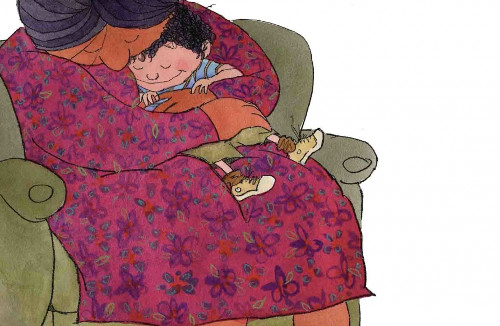
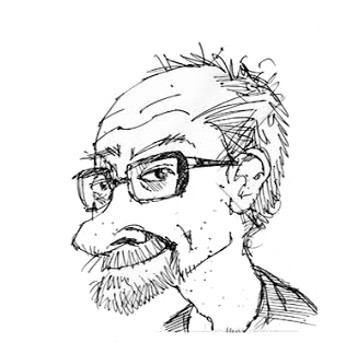 Well, dear readers, it’s been a while since I’ve done a breakfast interview. Since I’ve been teaching this summer, it takes me longer to get to these more time-intensive Q&As. My visitor today, illustrator Michael Emberley, deserves an award (or a free breakfast perhaps) for his patience with me. We started talking last year about doing this interview.
Well, dear readers, it’s been a while since I’ve done a breakfast interview. Since I’ve been teaching this summer, it takes me longer to get to these more time-intensive Q&As. My visitor today, illustrator Michael Emberley, deserves an award (or a free breakfast perhaps) for his patience with me. We started talking last year about doing this interview.
And I’m really glad we got around to it. I enjoy seeing his illustration work, and I really enjoyed chatting with him and hearing his responses to these questions. Emberley, the son of legendary illustrator Ed Emberley, has been illustrating since 1979. He was born and raised in Massachusetts but now makes his home in Ireland, near Dublin. (I highly recommend taking time to read this page of his site, where he talks about why he started illustrating and why he decided to stick with it: “I began illustrating because I needed money, but now I truly appreciate what I do. I can keep myself from being bored by doing a variety of book projects and using different techniques. This is more difficult than mastering one style but it is the only way for me.”)
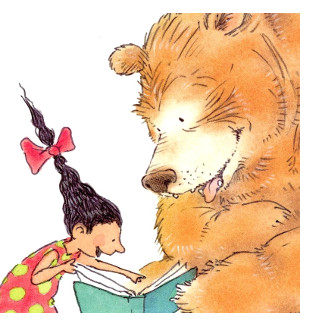 His work has been described as “an unassuming wonder” and “a playful masterclass in using the page.” His vivid characters leap off the page, and his loose-line watercolors communicate a spontaneity and energy that is infectious. His artwork also communicates the great warmth of family and friends; pictured at the top of this post is but one example of this, an illustration from 2008’s Mail Harry to the Moon, written by Robie Harris. And Emberley’s never been one to let gender stereotypes get in the way of his boy and girl protagonists; he had that covered well before it became PC to let such a thing happen.
His work has been described as “an unassuming wonder” and “a playful masterclass in using the page.” His vivid characters leap off the page, and his loose-line watercolors communicate a spontaneity and energy that is infectious. His artwork also communicates the great warmth of family and friends; pictured at the top of this post is but one example of this, an illustration from 2008’s Mail Harry to the Moon, written by Robie Harris. And Emberley’s never been one to let gender stereotypes get in the way of his boy and girl protagonists; he had that covered well before it became PC to let such a thing happen.
When I asked him about breakfast, I got a hearty response:
Hey! My favorite meal of the day! Okay. If writing early morning, good coffee and pastry in a café. If heading off cycling, add granola yoghurt and fruit or a ‘fry,’ if I need something extra. (A “fry” here in Ireland means [vegetarians, read no further]: sausage, rashers (thick bacon), eggs, black and white pudding (blood sausage), grilled tomato (pronounced toe-mah-toe), and a farl (potatoe pancake) if you’re up north. All on the same plate.)
A fry it is then. (Hey! If I don’t like it, well … it’s only a pretend cyber-breakfast.) And lots of coffee, of course.
Oh, and guess what? Michael shares below something he’s been thinking about doing for a while — a complete, single-scrolling image of all the sketches for one book. They are from Barbara Bottner’s Miss Brooks’ Story Nook, published last year. “I didn’t dare count them,” he told me. “Hundreds. It’s never been on any of my blogs or Facebook.” That is at the very bottom of this post.
I thank him for visiting 7-Imp.
Jules: Are you an illustrator or author/illustrator?
Michael: Definitely both. I’m an illustrator first, but I’m trying to get better at writing more “books without pictures.” But even when writing a novel, my mind is full of images — a theatre with sets and scenes, costumes and colored lights, players and performances. As I draw a picture book character, I hear them speaking. As I write about a middle grade character, I see their eyes. They’re real to me.
Pictured below: Sketch pages of different early ideas for Miss Brooks’ Story Nook (Knopf, 2014). See even more sketches in this 2014 7-Imp post.

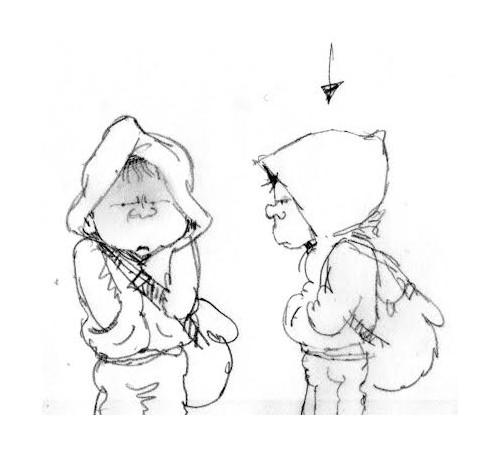
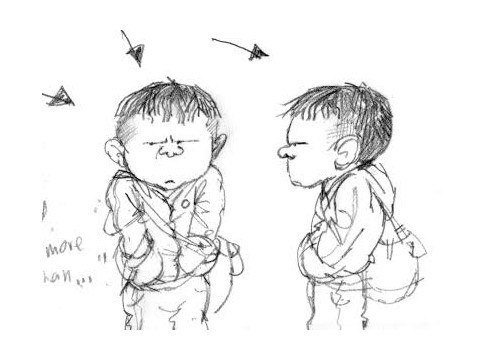

Pictured below: More sketches for Miss Brooks’ Story Nook, followed by a piece of final art. These were Michael’s “wish for a gruesome end to Billy by a Missy-conjured snake. None were accepted for final art. Notice even the final composition in the scene of the snake confronting Billy. I played around with different morphs of Missy into her imaginary snake. My idea of her turning into her creation can be seen in the sequential scene in the final book art where a close-up of her face/eyes is clearly becoming reptile, and then the snake becomes more a morph of her scarf (look at the color stripes and tail), but my original idea—using a half-Missy, half-snake head, though a more logical extension of the ‘snake eyes’ sequence—was ultimately rejected. It’s all subjective in fantasy.”

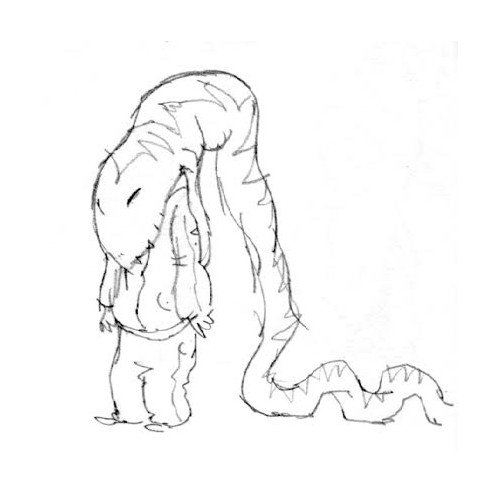
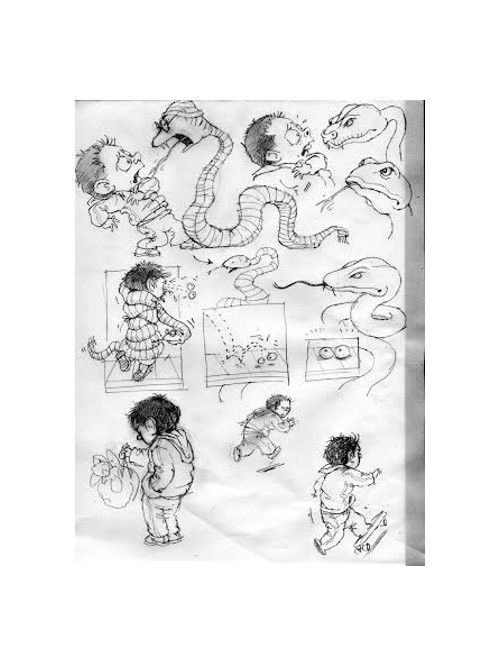
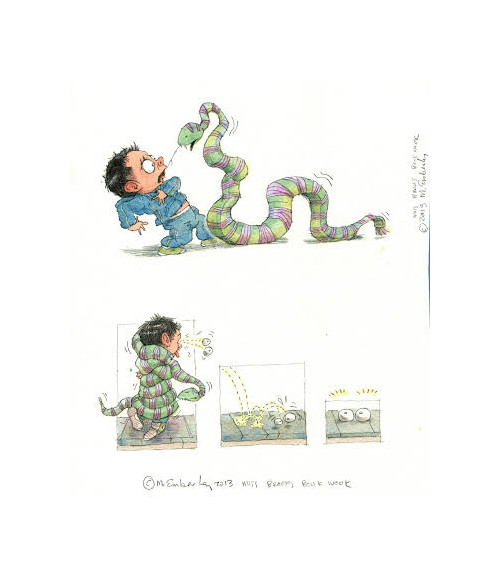
.jpg)
(Click to enlarge)
Pictured below: “Development of another hard-to-visualize concept of Billy being a yoke on Missy’s neck. Some things come out first draft with very little change in final art.”
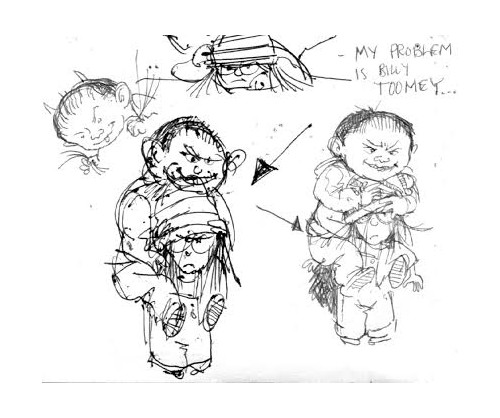
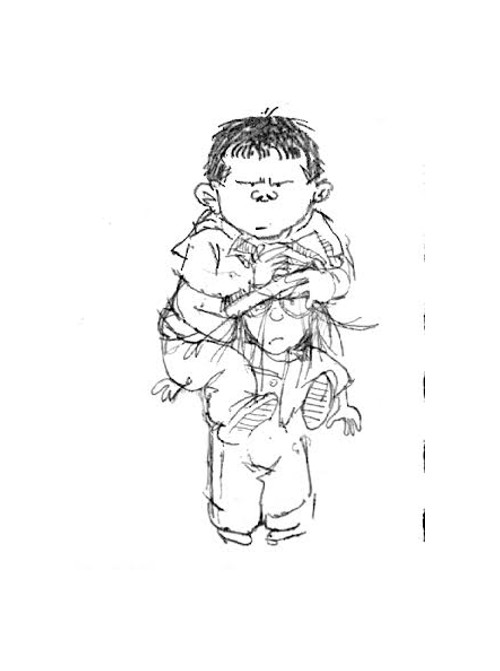
Pictured below: An unused concept for the neighbor’s basement:
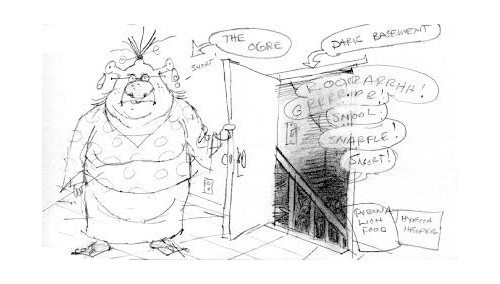
Pictured below: Lion sketches:
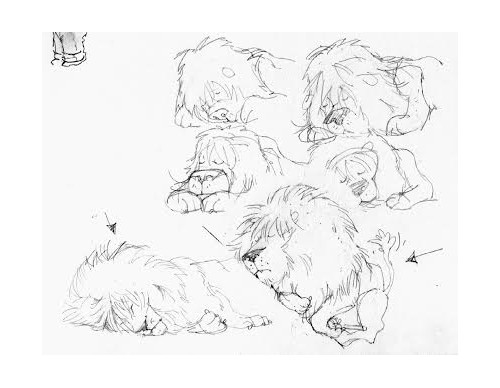
Pictured below: Ideas for Missy in her raincoat. Not used. “Note the skull pattern, expressing her less than stereotypical ‘girlie’ nature.”
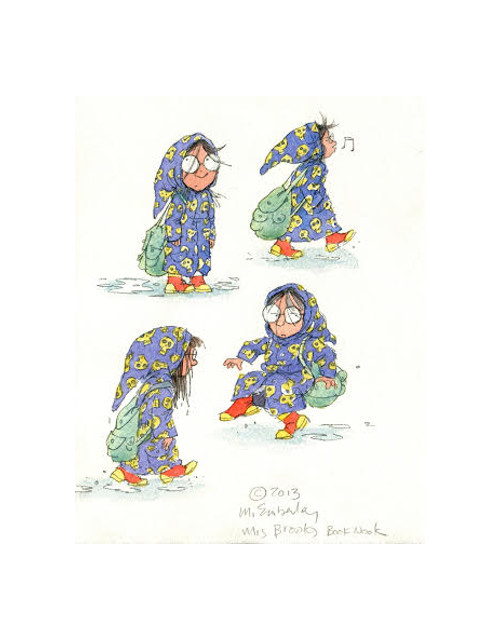

Pictured below: Some final art from the book:
.jpg)
.jpg)
.jpg)
.jpg)
.jpg)
.jpg)
.jpg) Jules: Can you list your books-to-date? (If there are too many books to list here, please list your five most recent illustrated titles or the ones that are most prominent in your mind, for whatever reason.)
Jules: Can you list your books-to-date? (If there are too many books to list here, please list your five most recent illustrated titles or the ones that are most prominent in your mind, for whatever reason.)
Michael: Yikes. Lots. I could list them, but it’s not nearly as impressive a list compared to what others have done. You can look at my website.
Unfortunately, I like to live life rather than spend it all in the studio. This will ultimately limit the number of books I finish, I guess. You can only do so much. I try not to be too hard on myself, but I usually feel I’m not working hard enough. The question is: What do I want to do with the finite time I’ve got?
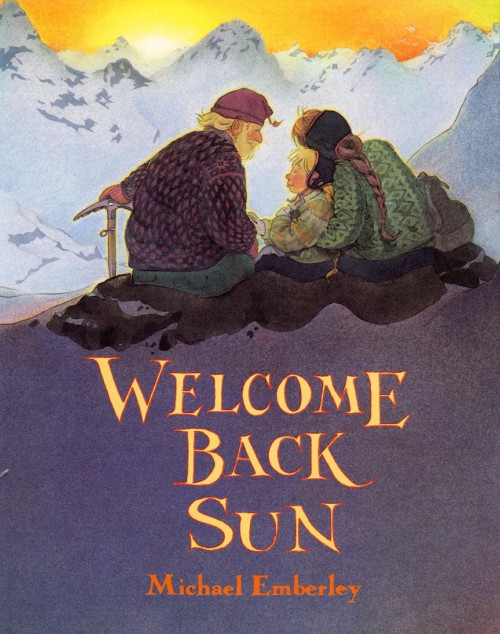
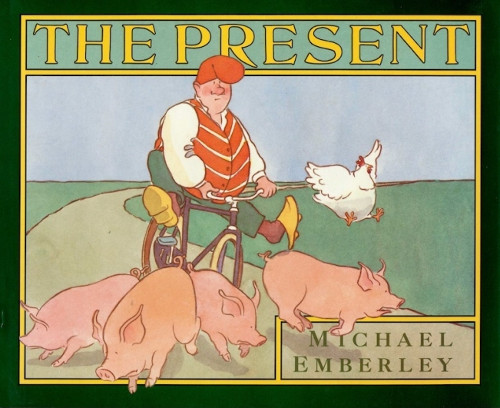
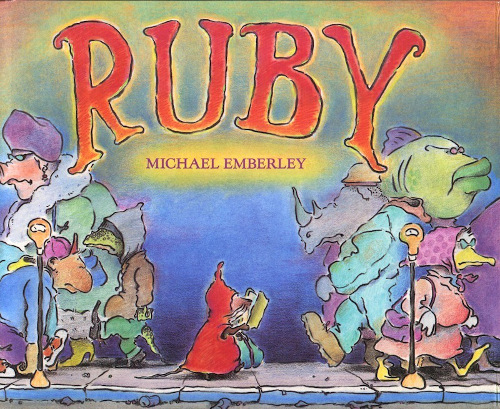
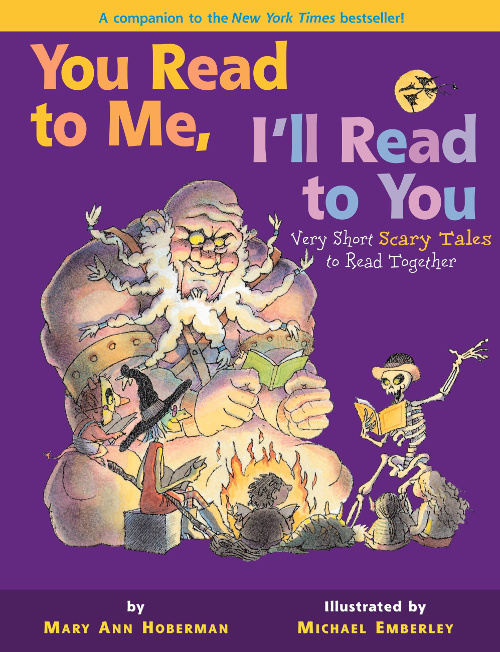
Jules: What is your usual medium?
Michael: Line, as I said, first and foremost. Preferably pencil. Sometimes pen. Occasionally brush and ink. [As for] color: Mostly liquid watercolor, but also dry pastel. If I could get away with just a pencil, I’d be happy. I’m experimenting with using digital color.
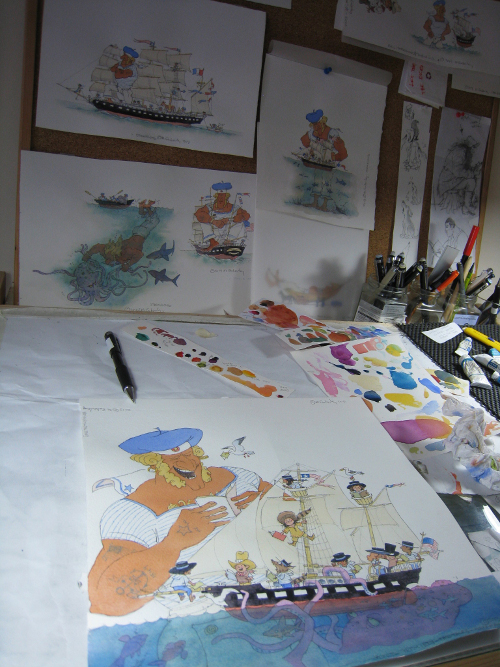

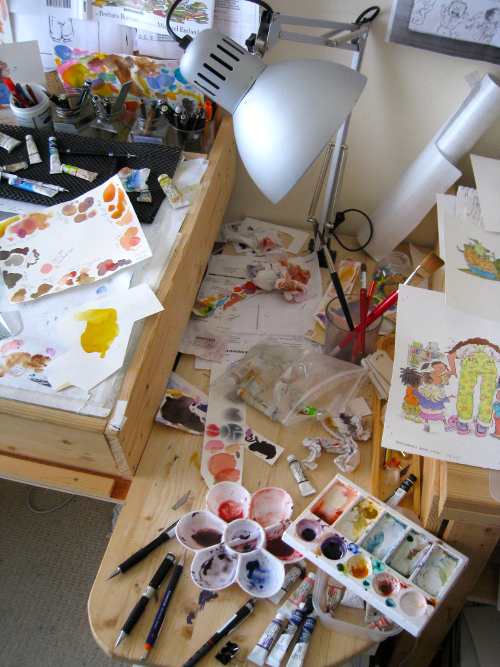
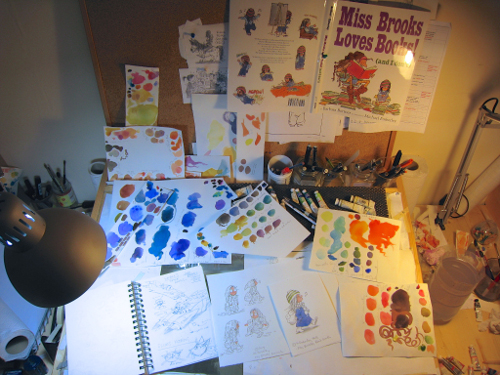
Jules: If you have illustrated for various age ranges (such as, both picture books and early reader books OR, say, picture books and chapter books), can you briefly discuss the differences, if any, in illustrating for one age group to another?
Michael: I’ve illustrated for young and old. Fiction and non-fiction. I love all ages. I wish I could draw for everyone. I do as much drawing making cards and notes for adults as I do for kids. I do a comic strip for my local coffee shop. It’s fun seeing people smile. I rarely get that from the book industry. I work so remotely from that whole world.

I have two favorites here. The rest are trash.”
Jules: Where are your stompin’ grounds?
Michael I’ve lived on the east coast and west coast of the USA (Boston, Oakland, San Diego) but now live in a small village on the east coast of Ireland, near the Irish Sea. We’re just south of Dublin, so we’re in the city a lot, too. It’s a beautiful spot for cycling (my other life) and close to trains and an airport shuttle. It’s getting too pricey, though, so my lovely Irish wife Mel and I may be forced to move soon. An artist is always being chased away by gentrification. My life has been pretty nomadic — at least 20 pillows so far.

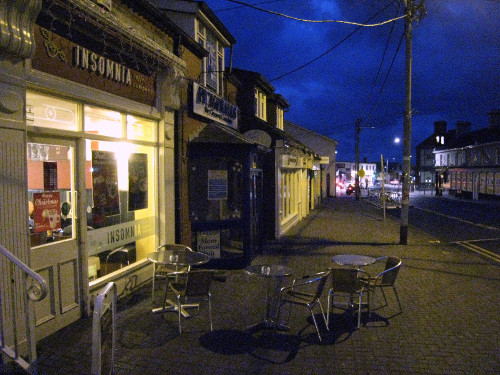

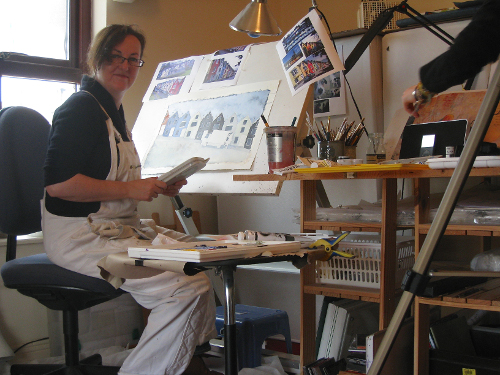

Jules: Can you briefly tell me about your road to publication?
Michael: Short story: My father was/is in the biz (Ed Emberley). He worked at home. I did odd stuff for him when I still lived there. A series of sketches I did for a drawing book he was working on was a failure, because it looked less like his work than he wanted, but instead of throwing it out, he suggested I take it away and make it into a stand-alone book for myself. Clever way of getting me to pay my way I took it in to my father’s editor, the kindly John Keller, and he said, “Let’s go!” I was 19 and never looked back. [That was] Dinosaurs! A Drawing Book, 1979.
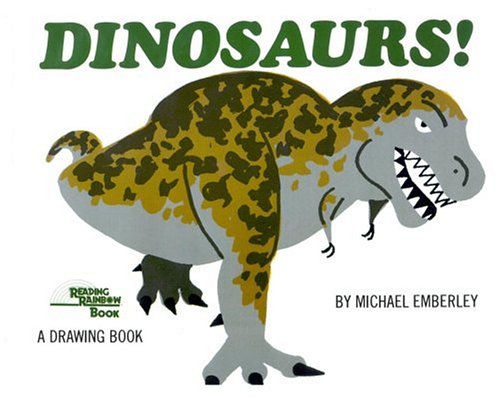
Jules: Can you please point readers to your web site and/or blog?
Michael: http://www.michaelemberley.com/.

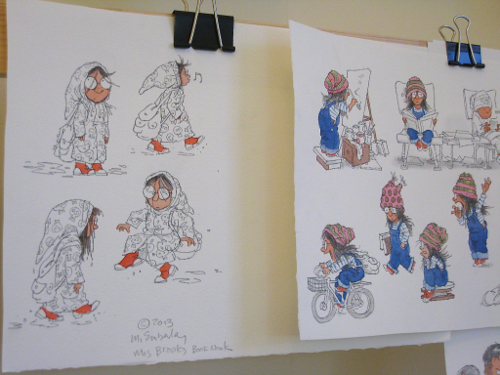
Jules: If you do school visits, tell me what they’re like.
Dan: They’re less about me and all about the prep that the school, teachers, librarians, and parents put into the visit. The more they put in, the better the kids are prepared, and the better it goes for everyone. I’m pretty good with the kids. I’m a kid myself. I can be very silly. I draw a lot. Most people like that.
But if they have no idea who you are or why you’re there, it’s like climbing Everest. Everyone loses. I should do more visits. But no one knows me here in Ireland. Very few of my books are sold here. My publishers claim the Irish don’t want my books. What can you do? I enjoyed visiting a tiny school in Co. Mayo recently. I got them rapping with me to one “You Read to Me” book. They’re so funny.
One thing I can say is I stopped prepping for specific audiences long ago, because I was blind-sided so many times with either a completely different age group or topic than I was told. Or it’s teens and five-year-olds in the same room. You have to think on your feet and read the vibe going on. I’ve done some seriously bad talks — and great ones. Worst was an ALA author breakfast years ago. I bombed. Best was my last U.S. gig – in Rhode Island, I think. The kids were great and, therefore, so was I. We all won.

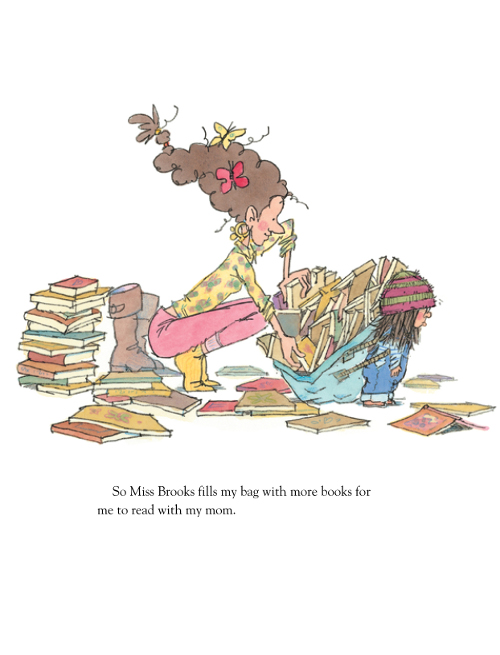
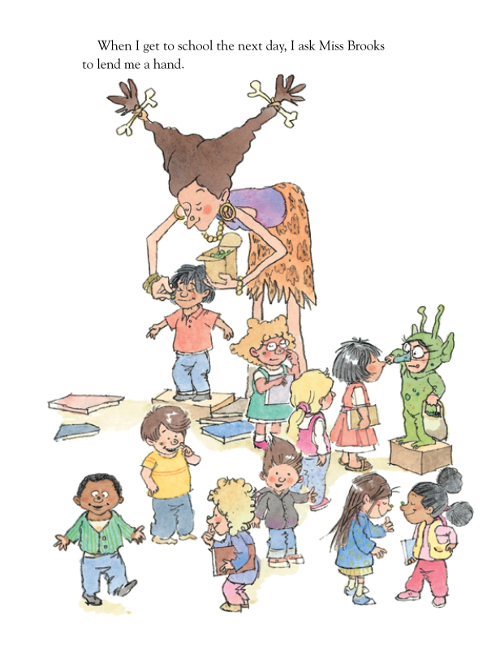

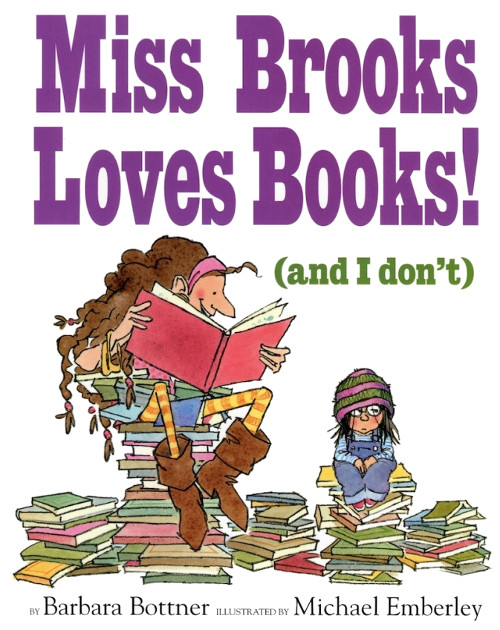
(and I don’t) (Knopf, 2010)
Jules: Any new titles/projects you might be working on now that you can tell me about?
Michael: Oh boy. Tons of stuff. I’ve taken time out this past year, making a big lunge back towards writing after mainly illustrating for several years. I’m writing for all ages. I have stuff for YA down to picture books. I have at least 15 manuscripts on the go. Yikes! I know: Focus on one, right? I’m working on that. But I’m too excited. I have so many books I want to do.
And I love all my new characters! Does that sound silly? I sincerely hope I can learn to write well enough so others will “meet” them and enjoy their company as much as I do. That sounds trite, but who cares? It’s true.


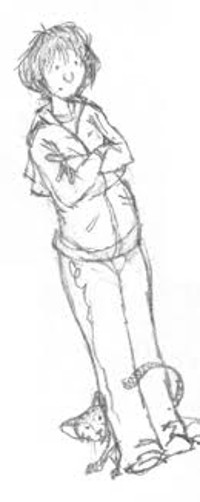
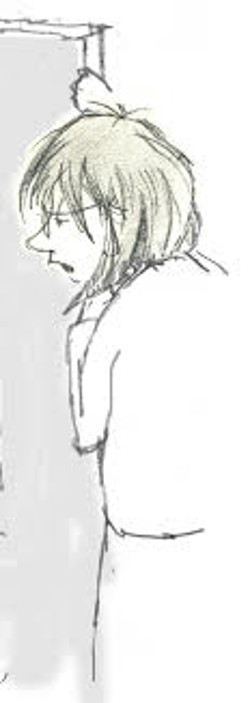
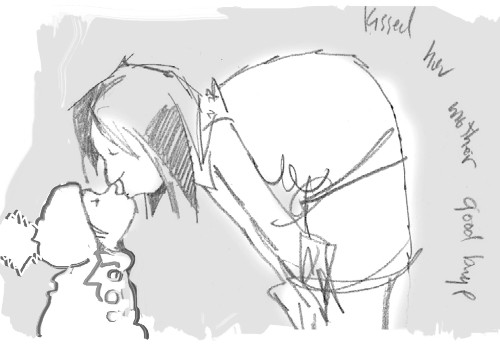
 Okay, we’ve got more coffee, and it’s time to get a bit more detailed with seven questions over breakfast. I thank Michael again for visiting 7-Imp.
Okay, we’ve got more coffee, and it’s time to get a bit more detailed with seven questions over breakfast. I thank Michael again for visiting 7-Imp.
1. Jules: What exactly is your process when you are illustrating a book? You can start wherever you’d like when answering: getting initial ideas, starting to illustrate, or even what it’s like under deadline, etc. Do you outline a great deal of the book before you illustrate or just let your muse lead you on and see where you end up?
Michael: Lots and lots and lots and lots and lots and lots and lots and lots and lots and lots and lots and lots and lots and lots and lots and lots and lots and lots and lots and lots and lots and lots and lots and lots and lots and lots and lots and lots and lots and lots and lots and lots and lots and lots and lots and lots and lots and lots and lots of sketching. I seem to do more and more as years go by. Loads of it done in coffee shops. I’ll use pencil, but since it smudges if you draw on the opposite page, I only use the right-hand pages. When I get to the end, I turn the sketchbook upside down and draw on those pages in pen. Hey, paper is expensive.
I do quite a bit of direct sketching on type layouts too. Impulsive ideas first — inventing the characters, their clothing, hairdos, and expressions. You know, the cast and performance of the play. I might add a few backgrounds. I only explore color in the finals, unless there is a color idea that dominates the scene.
I did this alphabet book with Barbara Bottner with 26 different kids and one teacher. I created 27 distinct individuals that moved through the book. Then I played them out. That was work. Lots of sketchbooks were filled on that one.
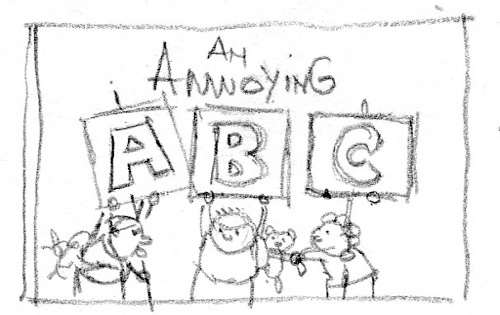
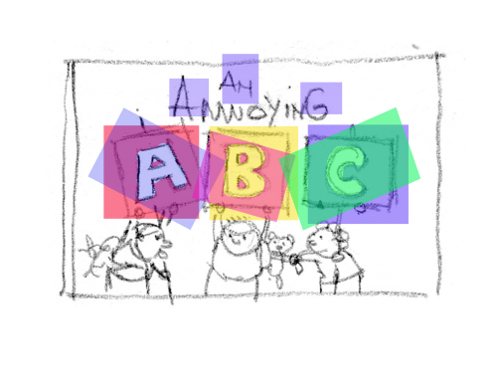
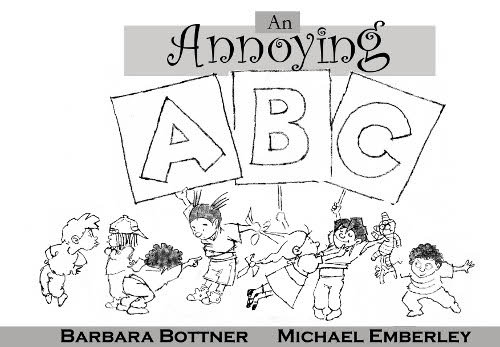
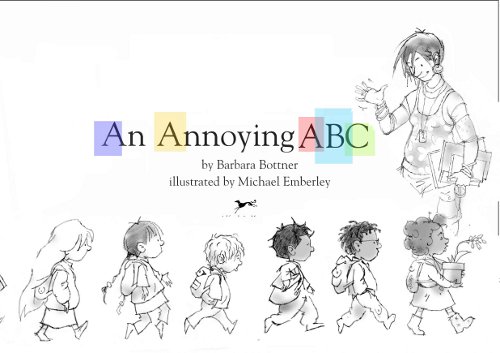
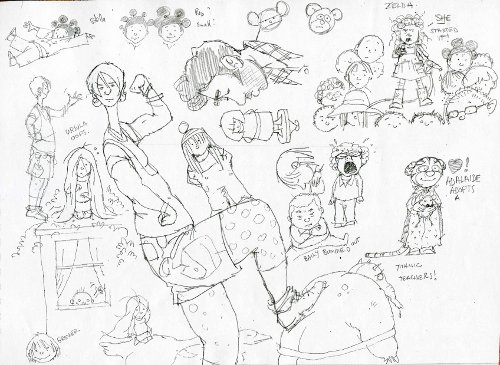



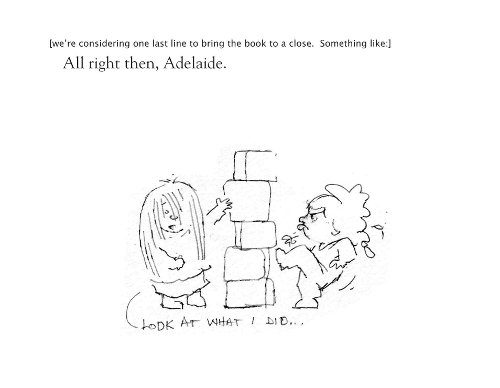
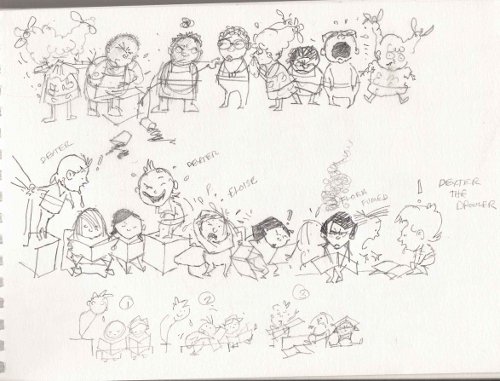
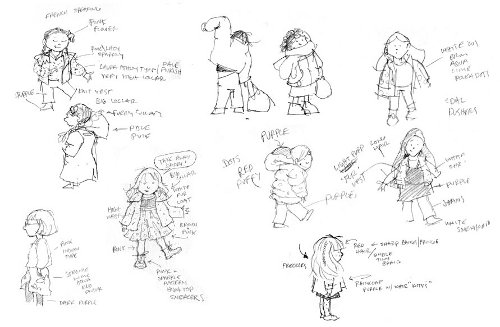
(Click each to enlarge)


2. Jules: Describe your studio or usual work space.
Michael: My workspace is wherever I am. I worked in a classic sixth floor factory building loft studio in Boston for ten years; in second bedrooms; in my own bedroom; in a closet-like space, like the one I’m renting at the moment. I make do. I get on with it.
My fantasy would be a bigger, well-lit, more open space to lay things out. A picture book is a whole, not discrete pieces. It’s great to see it all at once. But I can’t afford that kind of space right now. You make do. I’m writing this interview in my local pub. But maybe that’s an Irish thing.
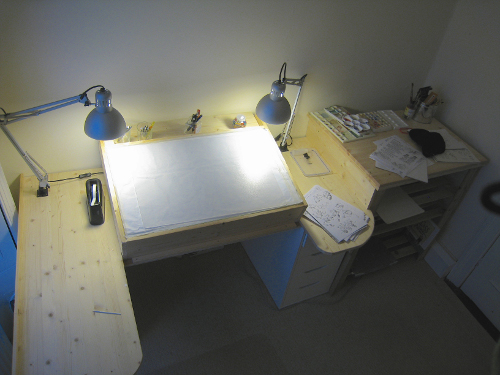


3. Jules: As a book-lover, it interests me: What books or authors and/or illustrators influenced you as an early reader?
Michael: My influences are few as a reader. I did not read much fiction as a kid, sorry to say. Mrs. Bowman read us Dahl in 3rd grade, and I loved it. I was forced to read things beyond my age and hated them, like Melville’s Billy Budd in 5th grade. That said, I loved all of Richard Scarry, Charles Shulz comics, and Charles Harper books.

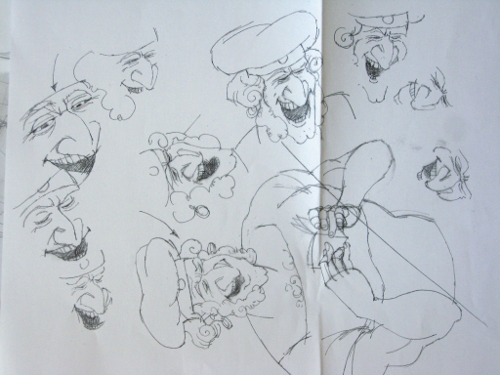
4. Jules: If you could have three (living) authors or illustrators—whom you have not yet met—over for coffee or a glass of rich, red wine, whom would you choose? (Some people cheat and list deceased authors/illustrators. I won’t tell.)
Michael: I like lots of people’s work. But it’s hard to know who would be a good dinner guest if I haven’t met them. A lousy artist might be great craic, and a brilliant one might only be good for, as a friend once described, “a couple of grim pints.” But it is nice to sit down with a fellow book person and not have to explain what you do the whole night.
I admire many people’s work and do occasionally wonder if they are anywhere near as interesting as their art/writing. “My authors” are all good craic. I met author Barbara Bottner at a gig once, and whether she believed me or not, I was a huge fan of her book, Bootsie Barker Bites. And I can tell you, she ain’t boring. It’s great to be doing books with her. Mary Ann Hoberman and her husband Norm are great dinner partners. My friends Robie Harris and her husband Bill are always great around the table.
[Pictured below: Art from Mary Ann Hoberman’s Forget-Me-Nots: Poems to Learn by Heart (Little, Brown, 2012). Read more about it here.]
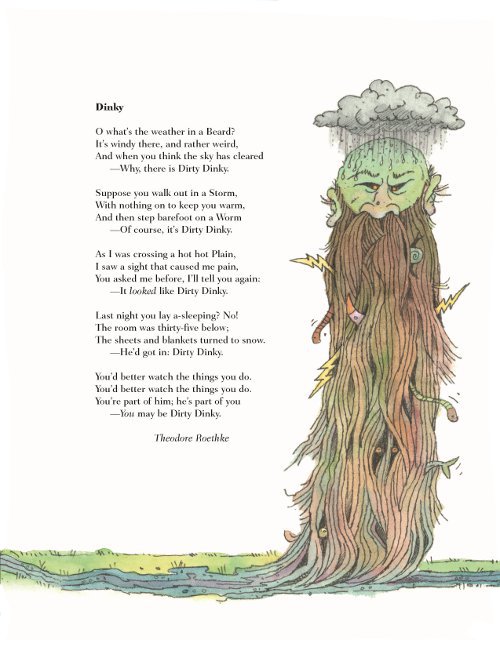

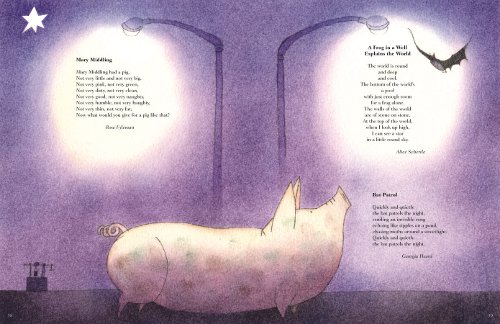
by Alice Schertle, and “Bat Patrol” by Georgia Heard
(Click to enlarge spread and read poems)
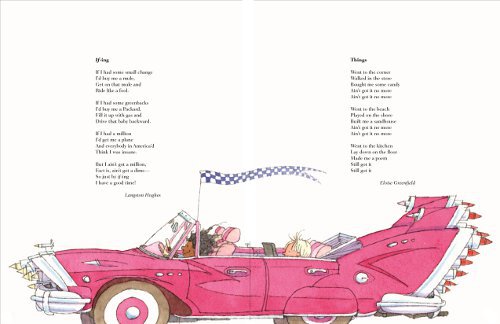
(Click to enlarge spread and read poems)
I like work I don’t imagine non-artists can truly appreciate to the same degree as another illustrator would. Brian Karas is a quiet genius. Ditto Ana Juan; Frida is a fantastic. I love Raúl Colón, Marla Frazee, and Jon Klasssen’s stuff is gorgeous. That tree house book — wow. Ed Young, the Dillons. Jim Kay’s work in A Monster Calls is one of the best things I’ve ever seen.
I love stuff I’ve seen from Spain, France, Germany, the Netherlands, and eastern Europe. I’m in love with stuff that won’t sell in the U.S. I would love to publish in Poland or someplace like that. France would be impossible to break into, but they have amazing children’s book illustrators. Japan too. Gorgeous stuff. The U.S. book-buyer can be too, uh, American, sometimes. Too limited in their tastes. There is a big world out there beyond the bright lights.
I love the comic/graphic novelists coming out of Europe and the U.S. They might be good for a laugh over a glass.
I want to talk to someone who sees no boundaries between art, science, religion, and philosophy. I like thinkers and dreamers. I like smart — but not at the expense of wonder. I like talking to people who teach me things but don’t lecture. I like people who can skip between genres and genders, fact and fiction, pain and persuasion. Someone who can stay off their phone. Someone funny and kind. If they are an artist, so much the better. But the creative arts is no secret passport to the land of interesting company. (Sounds like a personal ad!)
Writers? Hmmm. Too many. Short list:
- For kids: Sachar, Hiassen, Scieszka, Steig.
- For adults: le Carré, Gibson, Dibdin, Leonard, Maria Popova at Brain Pickings.
- Science writers: Brooks, Marcus Chown, David Bodanis.
- Comic writers: Dara Ó Briain, Stephen Frye, no question. But those are easy ones.
- Dead ones? Wilde, Swift, Shakespeare, Dickens.
Okay. That’s more than three, isn’t it?
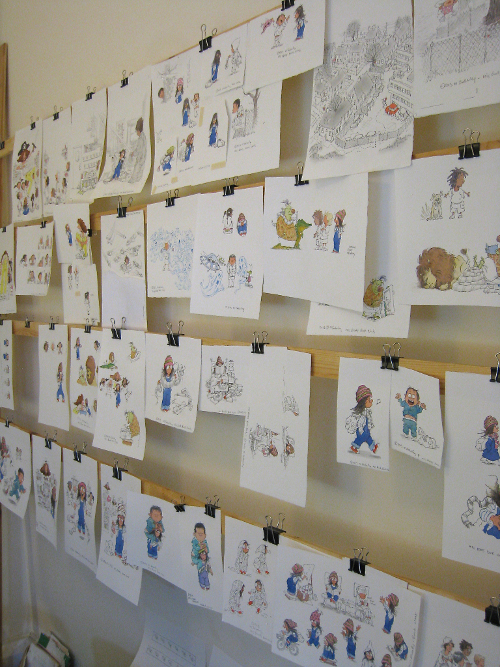
5. Jules: What is currently in rotation on your iPod or loaded in your CD player? Do you listen to music while you create books?
Michael: Tons of stuff. I listen all the time. All styles. Mostly when doing art. Writing is problematic with most music. But I write in noisy coffee shops with background music, so it’s possible. For example, West African is okay, since I don’t speak the lingo. Mainstream stuff — , Youssou N’Dour, etc. Puccini is nice, too, sometimes.
Random thoughts on music that’s sticking in my head recently:
Gillian Welch, “Everything’s Free.” Haunting song. And what better lament for the world of pre-internet/free content. I’m paraphrasing her lyrics here:
Everything is free now / That’s what they say / Everything I’ve ever done, They’re gonna give it away. … If there’s something that you wanna hear / you can sing it yourself.
I also keep listening to this acoustic version of Springsteen’s “Thunder Road.” I never listened to him before, and I’m not a groupie. But these lyrics, though, won’t go away. Paraphrasing again:
… it’s a looong walk from your front porch to my front seat / the door’s open, but the ride, it ain’t free.
I can see that grey wooden porch floor, feel the chasm between the screen door and the open car door. The gulf between what she knows and what could be waiting for her. The tremendous courage it takes to cross that porch, to imagine another future for herself. It kills me every time.
Eddi Reader. Check out the video “What You Do With What You’ve Got”. Amazing. Try to see this Scottish original live, singing her version of Robby Burns’ “Ae Fond Kiss.” And try not to feel it. This verse:
Had we ne’er loved so kindly
Had we ne’er loved so blindly,
Nor ne’er met, Nor ne’er parted,
We would ne’er been so broken-hearted.
Ah, as a Czech friend of mine once said, “Melancholy is best emotion.”
I admit I love Elvis Costello’s lyrics. Random lines I remember (some may be off):
“She threw her hands up, like a tulip…”
“They’re mopping up all the stubborn ones who just refuse to be saved.”
“He’s planting a paperback book for accidental purchase, containing all the secrets of life, and other useless things.”
Canadian Holly Cole has this amazing album of Tom Waits covers. Another great writer. Love the “doorknob” lyric in “Falling Down”:
Everyone knew that old hotel was a goner. … They broke all the windows, and took all the doorknobs, and they hauled it away in a couple of days. …
Also Cole’s other cover album with this song-lyric by Patty Larkin:
He said: ‘I read the Bible every day,
Just to keep the demons at bay,
Thank God when the sun goes down,
I don’t blow away.’
And one more: Lori McKenna‘s “Stealing Kisses.” Poignant “housewife drama”:
I was stealing kisses from a boy,
And now I’m begging affection from a man…
Don’t you know who I am?
I’m standing in your kitchen.
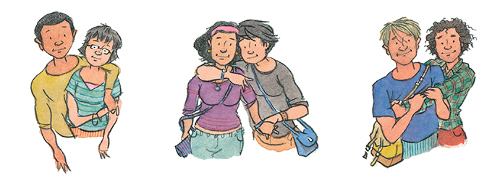
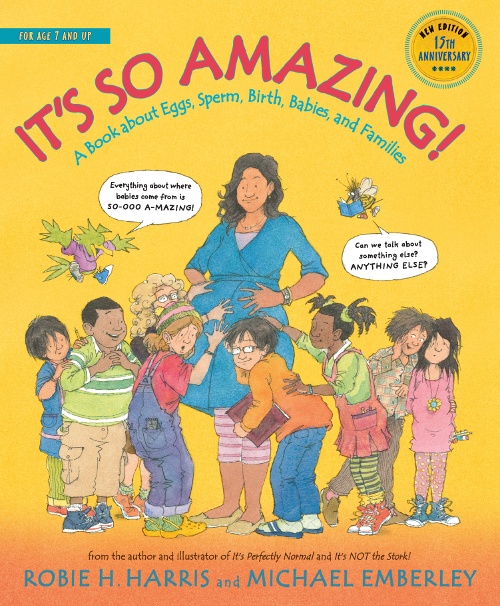
with Robie Harris (read more here)
6. Jules: What’s one thing that most people don’t know about you?
Michael: Well, most people who know me know this, but I am a competitive athlete when I’m not at the desk. Cycle racing has been my ‘thing’ since the late ’70s. It’s unusual in my experience for artists or writers to be athletic or competitive, and vice versa. I actually know no one who is in both worlds. A lot of artists/writers live in their heads all the time, come out at night, and they’re pretty neglectful or out of touch with their bodies.
The racing is a good balance for me. You can think out there. Mostly it’s training on back roads, wandering around, wind in your ears, a Zen thing, shutting down your “busy mind.” But racing itself is different. Aggressive, intense, clawing up hills, screaming down, diving into a sharp bend with people at each elbow. The pain, the exhaustion, the fear. Moving at high speed is an entirely different way of seeing the world than being in a chair.

7. Jules: Is there something you wish interviewers would ask you — but never do? Feel free to ask and respond here.
Dan: How does the way artists are perceived in society inform your decision to become an artist? Or: Why are you really doing this? No, I mean, really?
I grew up in a household with a professional artist. That’s my perspective. I saw the great Oz from the back first. Great artists seem to come from both great resistance and great encouragement. But it’s something you learn and earn, not get by faith or are born with. I think there’s too much mystery, awe, and romance surrounding artists and writers that they haven’t earned and, frankly, isn’t good for them. It does us no favors. It sets us apart, instead of bringing us together. Creatives all too often either marginalized or put on a pedestal by society.
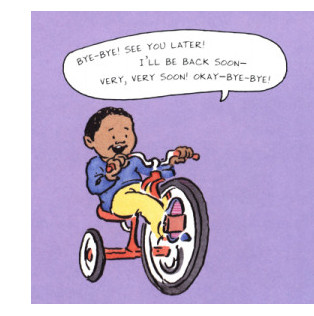 Here in Ireland, the attitude is pretty balanced: You’re given a comfortable chair, but no pedestal. That’s good. Pedestals are to knock people off of.
Here in Ireland, the attitude is pretty balanced: You’re given a comfortable chair, but no pedestal. That’s good. Pedestals are to knock people off of.
My pet peeve on the topic of the “artist’s life” is people who are writing or drawing so they can just “be the thing,” wrap themselves in the label Artist or Writer. Being an artist is just a name, a part of creating art, not the other way round. The goal is the work, not the label.
There are people who hold onto this thing they imagine an artist to be — some adolescent fantasy born from years of too much dreamy misinformation, like wanting to be a princess as a little child. To be famous—a celebrity—with the added thrill of being photographed, signing a hardbound book with your name on it. Jaysus feck. That’s the pinnacle of an adolescent dream, imagining being asked for their autograph.
Okay, I’d like to see art and writing and creative expression in general as something more acceptable and more readily available to a broader segment of the population. It’s a means of self-exploration and consolation — and generally enhances your life.
But that’s not professional art. There’s a difference. Professional art is work. You need to train for it, learn it, and hopefully get paid for it. It’s not something you do “if you only had the time.”
You wouldn’t expect anyone who likes to spin around in circles and likes how they look in a tutu to join the Bolshoi Ballet.
I think people should be asked more often why are they honestly doing it.
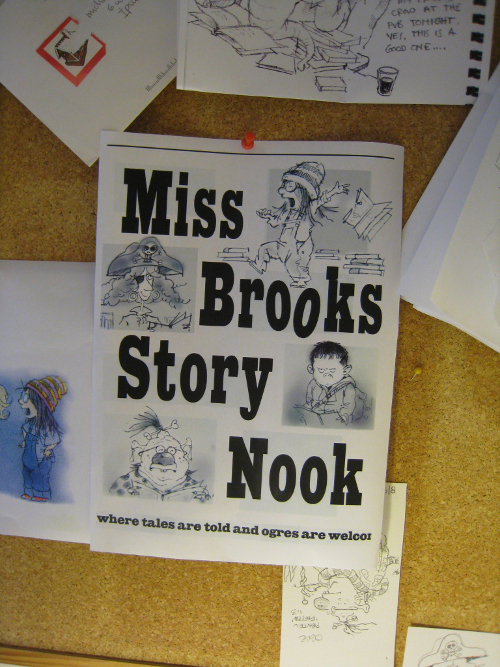
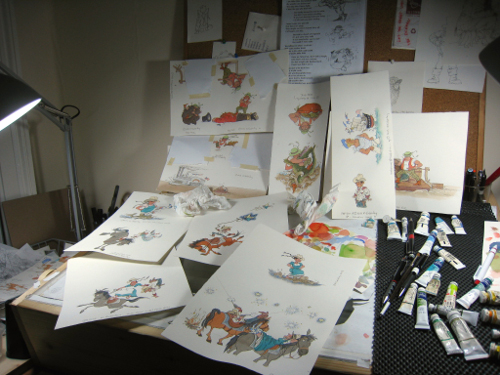
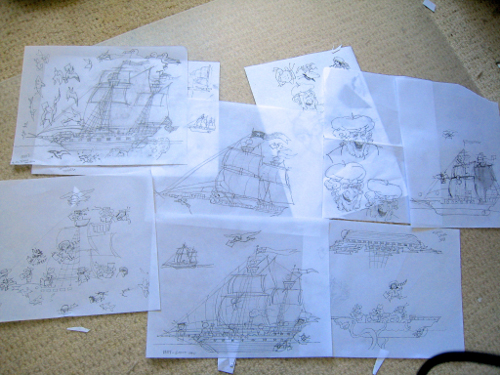



Jules: What is your favorite word?
Michael: “Balance.”
Jules: What is your least favorite word?
Michael: “Hate.”
Jules: What turns you on creatively, spiritually or emotionally?
Michael: Kindness.
Jules: What turns you off?
Michael: Bullies.
7-Imp: What is your favorite curse word? (optional)
Dan: “Me bollocks!”
Jules: What sound or noise do you love?
Michael: An Irish accent.
Jules: What sound or noise do you hate?
Michael: Loud, mechanical things at 7 a.m.
Jules: What profession other than your own would you like to attempt?
Michael: Theatre.
Jules: What profession would you not like to do?
Michael: Foreclosure.
Jules: If Heaven exists, what would you like to hear God say when you arrive at the Pearly Gates?
Dan: “Forgive yourself.”
Reminder: Below is a complete, single-scrolling image of all the sketches for Barbara Bottner’s Miss Brooks’ Story Nook, published last year.

All images are used by permission of Michael Emberley.
AN ANNOYING ABC. Copyright © 2011 by Barbara Bottner. Illustration © 2011 Michael Emberley. Published by Alfred A. Knopf, New York. Images reproduced by permission of Michael Emberley.
FORGET-ME-NOTS: POEMS TO LEARN BY HEART. Copyright 2012 by Mary Ann Hoberman. Illustrations copyright 2012 by Michael Emberley. Spreads reproduced with permission of the publisher, Megan Tingley Books/Little, Brown and Co., New York.
MISS BROOKS LOVES BOOKS! (AND I DON’T) Text copyright © 2010 by Barbara Bottner. Illustrations copyright © 2010 by Michael Emberley. Spread reproduced by permission of the publisher, Alfred A. Knopf, New York, NY.
MISS BROOKS’ STORY NOOK (WHERE TALES ARE TOLD AND OGRES ARE WELCOME!). Text copyright © 2014 by Barbara Bottner. Illustrations copyright © 2014 by Michael Emberley. Published by Alfred A. Knopf, New York, NY. Images reproduced by permission of Michael Emberley.
The spiffy and slightly sinister gentleman introducing the Pivot Questionnaire is Alfred, copyright © 2009 Matt Phelan.


Ooh, a farl, eh? Here a farl is a tattie scone, and I am well pleased to tell you that there are veggie versions of that fry-up!
I LOVE the first picture the very most, where the mum looks like she’s upholstered and the kid is squished in on her lap so nicely – that reminds me of “Mama Do You Love Me?” for reasons I don’t quite understand. This whole interview was LOVELY and full of all the things I love best about your Breakfast Interviews, Jules. Please don’t ever quit. We all appreciate them – and when people like Dan S. say so in their Caldecott speech, you KNOW what you mean to the kidlit picture book community!!
Fabulous interview! It was so well conducted and tells the story of this talented author/illustrator.
Michael’s visit to the elementary school where I was teaching in 1989 was one of his first. We became fast friends, I think due to the prep we had done prior to his visit. We had written newspaper accounts of what had happened to the cat in Ruby, and had created Urban and suburban spaces for a mural from The Present and Ruby. If the students aren’t engaged, the value of an author visit is lost, for the children and the author.
This is such a comprehensive interview! I can hear his voice and subtle humor, and enjoyed the stroll down Memory Lane. Thank you both for a wonderful piece.
[…] Click here to go see: http://blaine.org/sevenimpossiblethings/?p=3784 […]
I so enjoy your interviews with people whose work I truly admire, but it’s so much more delicious to discover you’d just love to meet the person! Thanks, Jules and Michael, even if I did save this to read over lunch!
I count my lucky stars that I met Michael and he agreed to read a manuscript of mine. I am a wildly enthusiastic fan, of our modern Daumier, such a keen observer of humanity with the skills to deliver what he sees, and torque the world with his wit and antic humor. From his work, you can see he is a writer indeed. His inner compass doesn’t falter and he has added such brilliance to my work, I am indebted indeed. Thank you Julie, for highlighting a light in the world of kids books.
What a great interview! And I’m not saying that because I was mentioned. I’d love to meet Michael sometime but I feel like I already have after reading your post. I love his work. So generous of him to share so much of it. His simple drawings are anything but. Only after seeing all of his studies do you get a real sense of what went into every expressive line. That’s the mark of a genius! Thanks for another inspiring interview.
Great interview. Love Michael’s spectacular work.